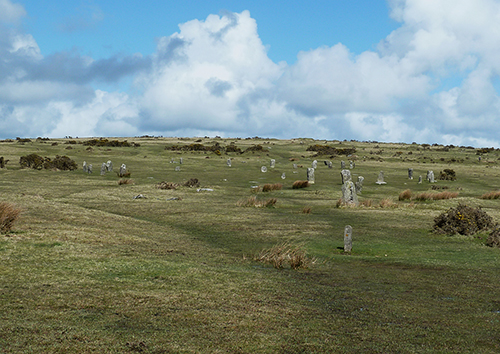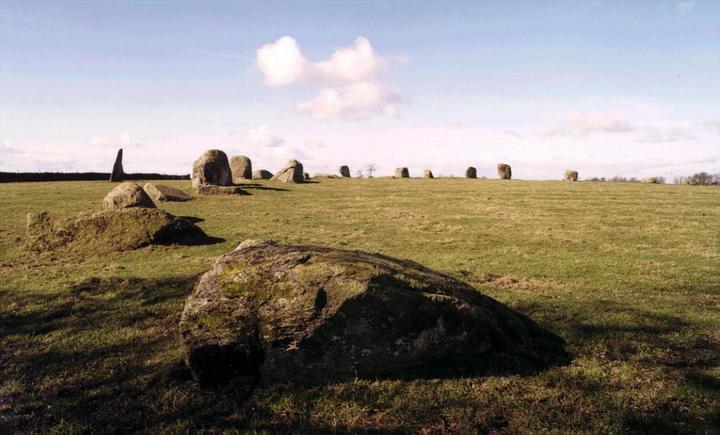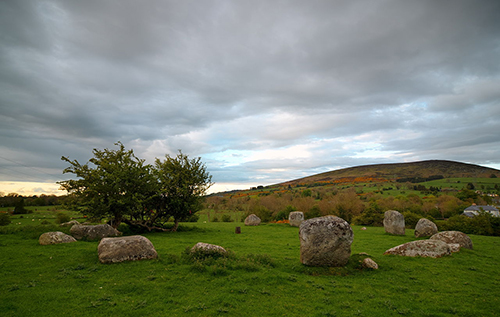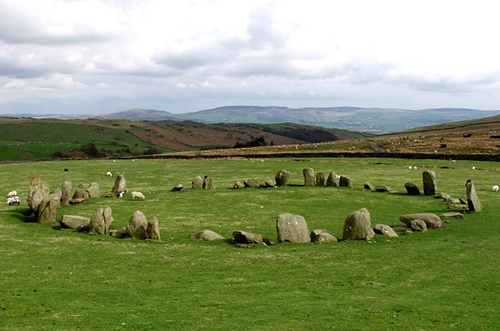Mention stone circles to many people, and they’ll think of people gathering at Stonehenge to watch the sunrise. Or hulking megaliths looming out of the mist on a lonely moor, the sheep being careful to only graze outside the circle.
They’re certainly evocative, if nothing else. As with the standing stones that we covered last week, we know very little about them. We don’t know why our ancestors built them or how they used them. Naturally, legend rushes in to fill that vacuum. Or does it?
This article has been surprisingly hard to write, since most of the folklore of these stone circles falls into one of two story types. That’s if the circles have any at all. I really wanted to include Castlerigg in Cumbria, as it’s the only circle I’ve actually visited, but there’s little folklore associated with it.
So this article will look at a handful of circles with folklore attached to them, before exploring those two story types.
I’m largely avoiding Stonehenge since in many ways it’s just too obvious, though one of the legends about it does appear here. I’m also not covering the Rollright Stones as I’ve covered them before here.
But let’s see what folklore we can find about these mysterious stone circles…
The Hurlers
The Hurlers are three circles on Craddock Moor near Likinhorne in Cornwall. People usually date them to the Bronze Age, or c. 1500 BC. Two standing stones lie WSW of the middle circle, known as the Pipers (Westwood 2005: 100).
According to William Camden in his Britannia of 1586, the circles were all originally men. They became stones after hurling (a ball-based sport) on a Sunday. Jennifer Westwood notes this origin story is unusual, since, as we shall see, most stories involving petrified people are a punishment for dancing, not sport. That said, the number of players required for hurling would explain the number of stones.
The Pipers may be a throwback to the dancing-based petrification since they bear little relation to hurling.
In 1675, Dr James Yonge recorded a new tradition. In this story, people could never count the number of stones. Eventually, a man put a loaf of bread on each stone, and could then count their number (Simpson 2003: 191). This idea of uncountable stones is common to stone circles, as we shall see.
Long Meg
This large circle in Cumbria is usually known as Long Meg and her Daughters. Long Meg is the 12ft stone that stands to one side of the main circle.
William Camden described them in 1610 under their current name, although he doesn’t give any folklore to explain the name.
In 1634, three soldiers reported 77 stones in the ring (Westwood 2005: 140). Victorians counted 66-67. Modern counts suggest 59. While tradition claims you can’t reach the same number twice when counting them, you do have to wonder if the number has gone down because people have removed stones over time. That said, one legend claims a fierce storm would rise up if anyone tried to uproot them.
Like the Hurlers, the legends claimed the stones were once people. In one version, they were witches, turned to stone as punishment. In the other, they were Meg’s sisters. Celia Fiennes described the story, saying the sisters were punished for “soliciting her to an unlawfull love by an enchantment” (Westwood 2005: 140). An 18th-century story claimed a saint turned the witches into stones for profaning a holy place, implying some kind of holy properties to the site itself. That said, it could also mean the witches profaned a holy day and were petrified for doing magic on a Sunday.
According to legend, Meg stands above buried treasure, much like the legend about the lone Mên Scryfa. The stone apparently bleeds if you chip pieces off (Simpson 2003: 216).
People gave any tall, thin woman the nickname ‘Long Meg’. So it’s likely the stone got the name for its shape, rather than a relationship to a woman named Meg (Simpson 2003: 216). Occasionally, people have assumed Long Meg must be Meg o’Meldon, the 17th-century businesswoman accused of witchcraft. Given Meg o’Meldon lived in Northumberland and has a range of other stories associated with her ghost, this is a really strange link to make.
Even more strangely, a story in 1860 claimed locals linked the stone circle of Michael Scot, the medieval wizard (Westwood 2005: 141).
Stanton Drew
Stanton Drew in Somerset boasts three stone circles, with a group of three standing stones called The Cove in a nearby pub garden. It’s likely antiquarian John Aubrey first recorded them in 1644, although the first maps date to 1723, by William Stukeley.
As with many stories of stone circles, legends explained the stones were a petrified party of people. Aubrey wrote that The Cove were the parson, bridegroom, and bride. Another group of stones was the band, while the circles comprised the dancing guests (Simpson 2003: 342).
Later, the story evolved, and the wedding took place on a Saturday. As the evening wore on, one player (either a piper or a harper) refused to play beyond midnight since it would mean playing on a Sunday. The furious bride claimed she would find another player even if it meant travelling to hell to fetch one. Hell came to her in the form of the Devil, dressed as an old man. He played and the company danced, but they found they couldn’t stop dancing, no matter how much they wanted to, and they became stone in the morning (Simpson 2003: 342).
We also find this in other places, such as The Nine Maidens in Cornwall, apparently turned to stone after dancing on a Sunday (Simpson 2003: 260).
In one legend, it brought bad luck, or even death, to correctly count the number of stones at Stanton Drew (Simpson 2003: 342). Even more strangely, one legend claims that the stones come to life at midnight on the sixth day after a full moon. They walk down to the river for a drink.
Athgreany Stone Circle
This stone circle in County Wicklow is also known as the Piper’s Stones, thanks to the local stories in which a piper and dancers kept playing and dancing on a Sunday. They were turned to stone for their trouble. You can spot the piper because he’s the stone slightly away from the circle to the northeast.
There are actually five circles in Ireland with the same name, showing the prevalence of this myth (Goldbaum no date).
Interestingly, Aubrey Burl pointed out that there may be a folk-memory associated with these stories of dancing and stones (1976: 84-85). While it’s not a specific memory per se, it’s possible that people knew prehistoric people danced, and the circles would make a good location for this. Another explanation given for the name is that people hear bagpipe music in the area, though that could be fairy music (Goldbaum no date).
Its name translates to Field of the Sun (Áth Gréine in Irish). There’s also a hawthorn tree in the circle, linking it with the fairy folk. Even now, people hang strips of cloth on the branches, turning the hawthorn into a clootie tree (Goldbaum no date). Given the prohibitions on felling hawthorns, especially lone hawthorns, this tree seems to have survived rather well.
Sunkenkirk Circle
Lest you think all stone circles are related to petrified people, the Sunkenkirk Circle in Cumbria (or Swinside Stone Circle) has different stories attached to it.
True, one of its common legends is that the stones are un-countable (Westwood 2005: 146).
A report in 1902 claimed the stones were originally to be used to build a church. The Devil came along at night and made the stones sink into the ground. This is reminiscent of the legends in which the Devil (or fairies) move the foundation stones of a building to a different site, such as the Callaly Castle story (Westwood 2005: 146).
Yet Sunken kirk is also a traditional name found elsewhere – not just at prehistoric sites. Some think this is because the ground is believed to be boggy, and had swallowed up a church thanks to the poor terrain.
But let’s have a look at those two common themes – the countless stones, and the petrified people.
Countless Stones
The belief about stones being countless has been traced back to 1581 (Menefee 1975: 146). So famous had the tradition become by the mid-17th century that Charles II apparently spent time on 7 October 1651 trying to count Stonehenge’s stones, one of the monuments famous for its apparently countless stones (Menefee 1975: 147).
Even Inigo Jones and Samuel Pepys even had a go at counting them. Celia Fiennes visited Stonehenge in 1690 and confidently asserted there were 91 stones (Menefee 1975: 147). Yet this particular belief is found across England, Wales, and Ireland. While it’s possible that someone might have heard a story about countless stones while travelling and then imposed it upon their local stone circle, is that likely for all of them?
S. P. Menefee addresses this, saying that on one hand, the stones often look alike, making it difficult to know which ones you’ve counted, and it can be hard to know which ones to include as part of the circle, and which ones are simply nearby (1975: 148). He does suggest that if you look at legends associated with La Roche-aux-Fées in Brittany, a Neolithic gallery grave, you can see other reasons. In one, the stones can move, and therefore confuse the counter, and in the other, the Devil plays tricks on the person counting (1975: 148). The third option is that there’s a spell on the stones, which is one of the theories applied to Stonehenge.

The idea that the stones can move on their own isn’t unusual since animism explains the stones have their own spirit, and might have their own business to attend to. In a Christian setting, such movement would then be recast as Satanic.
People try to count them anyway
In some cases, people faced retribution for attempting to count the stones. Some legends claimed the person would die if they counted the right number. Someone counted the stones at Stanton Drew in 1750, and soon after doing so, there was a sudden downpour, which locals linked to the counting (Menefee 1975: 149).
This even pops up in the stories about bakers putting loaves on the stones. In some variations, the baker drops dead before he can call out the number. In others, a loaf vanishes to be replaced with the Devil (Menefee 1975: 149). Why bread? Menefee notes the apparently protective nature of bread (1975: 154). You can read about bread folklore here and make up your own mind about that one.
A side motif sees people mark one stone, meaning to then count around the circle from that point. When they leave to run an errand, they return to find every stone bearing the same marker. One story from County Galway sees a milkmaid use a cow-bit to mark treasure found at a circle. When she returned, she had no way of knowing which cow-bit was the right one (Menefee 1975: 153).
The peril of counting things appears in other superstitions, such as it bringing bad luck to count the visible stars. I don’t know if this is linked to the idea that you could deter vampires by planting juniper by your door, since the vampire would have no choice but to stop and count every leaf. Is it possible that the deterrent posed by counting something innumerable explained why people thought counting stones to bring bad luck, especially since the stories are always linked with vast circles?
The Stones as Petrified People
The belief that stone circles were petrified people who’d been breaking the Sabbath dates to 1602 (White 2014: 62). The legend varies across different numbers of dancers, their relationship to one another, the musicians present, and what role the Devil played. In the so-called ‘Merry Maidens’ tradition, the dancers are always women.

In many cases, the party was dancing to celebrate a wedding and the dancing continued into the Sabbath. Yet other variations exist, which see people petrified for failing to salute the cross, or not showing proper respect for funerals or processions (Menefee 1974: 24). Menefee thinks the Sabbath motif came from the ‘Merry Maidens’ legend type. Labourers were punished for working on a Sunday. The Devil might also tempt people into breaking the Sabbath, often through his fondness for card games.
The story type looks like a cautionary tale. Though it’s also possible people simply kept the legend alive to explain the existence of the circles. After all, in the absence of any knowledge about their function, the legend is as useful as anything else.
What do we make of stone circles?
It’s fascinating that the legends can be divided so easily into two camps. True, other circles add extra tidbits, like stones going for a drink, or marking sunken churches. But on the whole, it’s either bad luck to count the stones, or the stones were once people. Or both.
It’s unlikely these stories were fossilised folk memories, passed down across the ages. The ‘Sabbath breaking’ motif only dates to the Middle Ages at best, and clearly couldn’t pre-date Christianity. Meanwhile, the inability to count the stones reflects other lore about not counting anything that comes in big numbers. Perhaps it also harks to a time when education rates were lower, and people couldn’t count the stones.
While some now consider the stone circles a sacred site, we still don’t know what they’re for or how people used them. They might be sacred, or they might turn out yet to serve a really mundane purpose. Either way, if you do visit one, remember to leave only footprints and take only photographs.
After all, the Devil seems to be fond of them…
Which is your favourite stone circle?
References
Burl, Aubrey (1976), The Stone Circles of the British Isles, New Haven: Yale Yale University Press.
Goldbaum, Howard (no date), ‘Athgreany Piper’s Stones’, Voices from the Dawn, https://voicesfromthedawn.com/athgreany-pipers-stones/.
Hutton, Ronald (2014), Pagan Britain, New Haven: Yale University Press.
Menefee, S. P. (1974), ‘The ‘Merry Maidens’ and the ‘Noce de Pierre”, Folklore, 85 (1), pp. 23-42.
Menefee, S. P. (1975), ‘The ‘Countless Stones’: A Final Reckoning’, Folklore, 86 (3/4), pp. 146-166.
Simpson, Jacqueline and Steve Roud (2003), A Dictionary of English Folklore, Oxford: Oxford University Press.
Westwood, Jennifer and Simpson, Jacqueline (2005), The Lore of the Land: A Guide to England’s Legends, London: Penguin.
White, Ethan Doyle (2014), ‘Devil’s Stones and Midnight Rites: Megaliths,
Folklore, and Contemporary Pagan Witchcraft’, Folklore, 125, pp. 60-79.
Nutty about folklore and want more?
Add your email below and get these posts in your inbox every week.
You'll also get my 5-step guide to protecting your home using folklore!












My favorite is Avebury and I also liked the Rollright Ring. I’ve been to Long Meg and heard the witch story. I never heard the stones were people story at Avebury and I will have to search for your piece on Rollright. We were totally led there, and it felt wonderful.